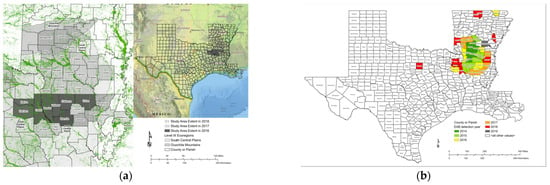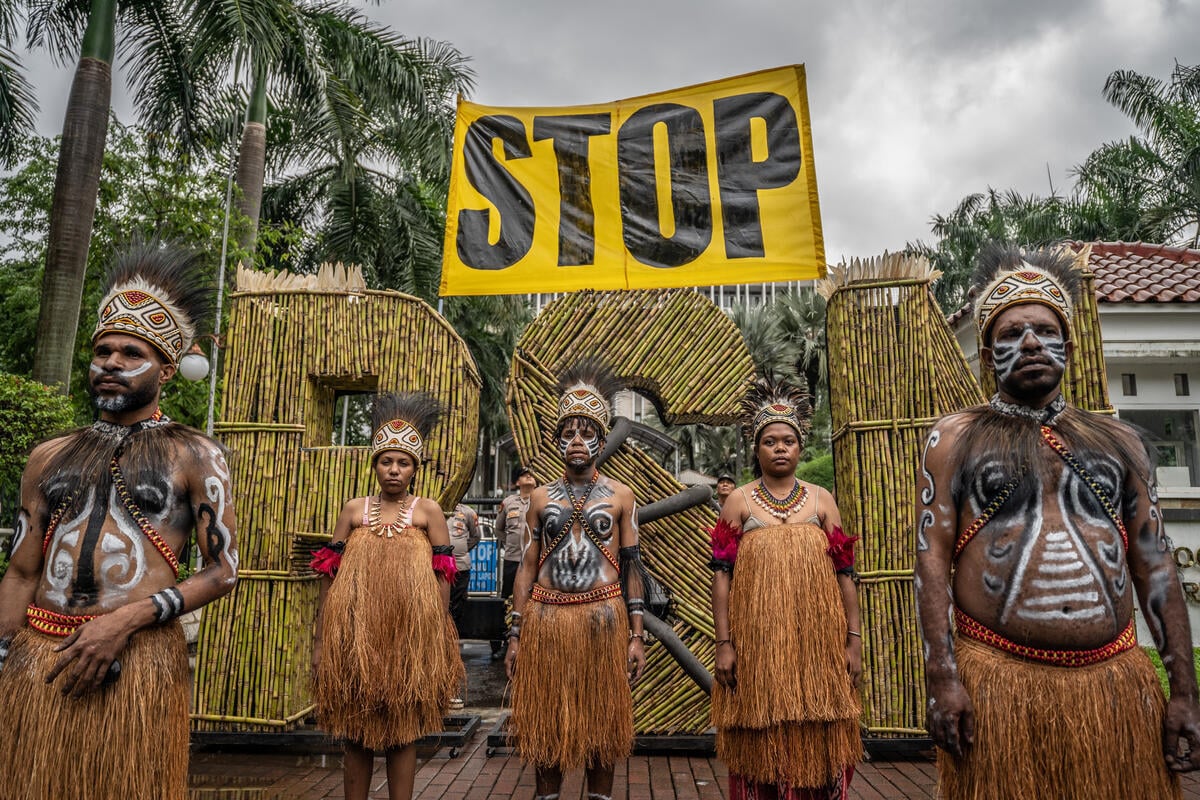1. Introduction
The emerald ash borer (Agrilus planipennis Fairmaire; EAB) is an invasive forest insect that threatens all ash (Fraxinus spp. L.) tree species. Since it was first identified in 2002, EAB has expanded its range to 35 U.S. states and 5 Canadian provinces [1]. The expansion of EAB into the southern United States represents a turning point in the insect’s biology, with speculations regarding population growth and demographics. Moreover, the ash hosts in these southern states are sparse and are mainly distributed along major streams and rivers, in contrast to the abundant and ubiquitous ash distribution in the northern invasion range, thus influencing EAB’s short- and long-distance dispersal [2]. As phloem and cambium feeders, EAB larvae can kill ash trees from within three to five years after establishment [3].
EAB Adults respond to visual cues and are attracted to green and purple hues as well as host volatiles and contact sex pheromones [4,5]. Female EABs produce a short-range pheromone (<5 cm; (3Z)-lactone); however, no long-range pheromones have been identified [6,7,8,9,10,11]. Visual symptoms of infestation include D-shaped exit holes on the trunk, larval galleries under the bark, epicormic branching, woodpecker feeding, bark splits, and general canopy decline, and are not noticeable until the EAB population is well established [12].
The traps most used for EAB detection and monitoring were the Lindgren multifunnel trap and the corrugated plastic three-panel, or prism, trap. Multifunnel traps have a long history of use in bark beetle (scolytid) trapping [13], whereas the use of corrugated plastic panel adhesive-coated prism traps in an operational detection program is more recent and specific to EAB [14,15]. The three-sided sticky panel traps represent an improvement over early designs that included single panel, box, and cross-vane traps [15,16]. The Lindgren traps consist of collapsible funnels linked together vertically to provide a tree-like silhouette. Although Lindgren traps are reusable and eliminate the need for adhesive coating [17], their use in EAB field surveys is limited due to their bulky size (12–16 funnels), need for a slippery coating (e.g., Fluon), and relatively high maintenance [18].
Green and purple color traps have been demonstrated to be highly attractive to EABs. Retinal sensitivities of EABs peak in the ultraviolet, violet, blue, and green regions of the electromagnetic spectrum, which highlighted the potential for use of these colors in trap designs [4]. Mated females appear to be more sensitive than males to the red region of the light spectrum, which resulted in the use of purple (red and blue) traps in detection and monitoring surveys [4,17]. In optimizing green and purple panel traps, green wavelengths from 525 to 540 nm and a purple color, with reflectance at 12.5% for the red (670 nm) peak reported to be most attractive to EAB [19]. Purple traps with the 12.5% reflectance were more effective than standard purple plastics produced by Coroplast Inc., Granby, QC, Canada, and used in the annual EAB National Survey Program, conducted by Animal and Plant Health Inspection Service (APHIS) [19]. Unbaited dark green panel traps placed at the midpoint of ash tree crowns caught three times more adults than purple traps [4]. At low EAB population densities, green multifunnel and purple panel traps had a comparable proportion of traps with at least one catch during trapping season (i.e., detection rate), although the green multifunnel traps had higher adult catches than purple ones [17]. This higher adult catch has been attributed to the green color traps’ resemblance in reflectance to ash foliage available during the adult flight period [19]. The greater attraction of female EABs to purple traps is attributed to the similarity in reflectance to ash tree bark, in which females oviposit [4,20].
EAB’s ability to use host-specific volatiles to locate trees, especially stressed ones, led to the identification of bark sesquiterpenes and leaf volatiles that elicit adult EAB antennal activity [20]. The identified antennally active bark volatiles also have been found in manuka and phoebe oils, which are steam distillates from the manuka tea tree (Leptospermum scoparium) and Brazilian walnut tree (Phoebe porosa), respectively [8,20]. Phoebe oil contains all six antennally active bark volatiles that were identified in the ash tree host, whereas manuka oil lacks one [8]. The green leaf volatile (Z)-3-hexenol had the highest antennal response by males as compared to other hexyl compounds, whereas females responded similarly to all tested hexyl compounds [21]. Bark sesquiterpenes appear to be more attractive to EAB females, whereas green leaf volatiles appear to have an important role in host and mate finding by EAB males [22]. Both bark and ash leaf volatiles were used in the annual EAB National Survey Program, conducted by Animal and Plant Health Inspection Service (APHIS), since 2008.
Trap placement (i.e., height and location within tree crown and surroundings) mediates EAB responses to both lures and trap type and color. Adult activity appeared higher in the upper crowns of ash trees, mostly in warm and sunny conditions, and more EAB males than females were observed hovering around trees [23]. Open grown, edge trees, and southern aspects also are attractive to EAB adults [24,25,26]. Consequently, more males are caught in green traps placed in ash tree crowns than those placed near ground-level [22]. When traps were placed at 1.5 m above ground, no significant differences in mean adult catches were detected between green panel traps, which attracted more males, and purple panel traps, which attracted more females [4]. Traps placed at midpoint in ash tree crowns had higher adult catches for green traps, whereas no difference in adult catch counts were detected for traps placed at 1.5 m above ground [19]. Trap placement higher in the canopy appears to increase EAB adult catch and is an important factor in improving the EAB detection rate.
Several studies have compared EAB adult trap catches and detection rates using various lure combinations. Dark green panel traps baited only with the (Z)-3-hexenol had comparable catches to those traps baited with manuka oil plus (Z)-3-hexenol [22]. Adding (Z)-3-hexenol to manuka oil lures increased the count of males caught and adult total count as compared to manuka oil alone [22]. Using an 80:20 mix of manuka and phoebe oils caught more EAB adults than standard manuka oil lures used in the National Survey Program [22]. The attractant effect of (Z)-3-hexenol was dampened in dark green panel traps [22], but enhanced in light green panel traps hung in ash tree crowns [27]. Combining the antennally active short-range sex pheromone (3Z)-lactone with (Z)-3-hexenol resulted in increased capture of EAB males, but slightly lowered female capture when green traps were placed in ash tree crowns [28].
Based on results from trap comparison studies, recommendations for operational detection programs were developed. For example, [4,19,27] suggested that the most effective traps for EAB detection are green panel traps, preferably light green 540 nm, placed at midpoint in ash tree crowns. More recently, (Z)-3-hexenol baited dark green multifunnel and double decker (two panel traps, with dark green upper and light purple lower, attached to a 3 m pole) traps were recommended in a comparison of the most promising operational survey trap types, colors, and lure combinations [29]. Although these comparisons were made in areas of varying infestations levels, they were consistently performed in areas with an abundant and ubiquitous ash tree distribution. Despite evidence for increased colonization likelihood with high host abundance [30] and increased EAB spread when the host is distributed in a linear fashion, such as along roads or waterways [2,31,32], it is still unclear how trap efficacy is influenced in areas with scattered or clustered ash distributions, as is the case in Arkansas, Louisiana, and Texas. Therefore, operational survey trapping recommendations may require revision in areas of sparse and linearly distributed hosts.
The objective of this study was to compare EAB adult catch, detection rate and male/female attraction among four combinations of panel traps within an area of varying infestation levels and sparse ash host distribution, occurring mainly along major rivers and waterways, in Arkansas, Louisiana, and Texas. The four combinations included various, but not the full, factorial levels of lure, color, and tree crown placement, and were specifically as follows: (1) mid–upper crown with (Z)-3-hexenol alone; (2) mid–upper crown with (Z)-3-hexenol plus (3Z)-lactone; (3) lower crown with (Z)-3-hexenol alone; and (4) lower crown with (Z)-3-hexenol plus (3Z)-lactone. For the combination of mid–upper crown with (Z)-3-hexenol plus (3Z)-lactone, a light green panel trap was used as has been previously shown to be superior. A dark purple panel trap was used for the remaining combinations, as was used in the EAB National Survey Program. No unbaited control traps were used in this study, as the usefulness of these traps and lures in EAB detection is already established [4,10,19,22] and this study’s focus was on comparing the effectiveness of trap lure, color, and tree crown placement combinations rather than determining their enhanced performance over a control. Lower crown placement corresponded with standard placement for the EAB National Survey Program in the lower crowns of ash trees at no lower than 1.5 m above ground [33], whereas mid–upper placement corresponded to improved green trap efficacy at mid, ~13 m, crown placement [4,19,27].
4. Discussion
It was expected that fewer adults and lower detections would be recorded in 2017 and 2019. Traps were placed in non-symptomatic ash trees outside of the periphery of the known infested area of northern Louisiana in 2017. Trapping occurred in one of the earliest EAB confirmed counties (Clark County, Arkansas) in 2019, where beetle populations were more likely on the decline following the crest stage of the invasion wave [42]. Although trapping trees were similar in sizes for 2018 and 2019, trees selected during 2019 were in more advanced stages of decline corresponding to the post-invasion dynamics of EABs. Moreover, the higher proportion of selected trees within wooded interiors in 2019 may have further influenced the availability and capture potential of EAB adults.
Mid–upper tree crown, ~13 m, placement of panel traps was more effective for EAB adult detection and capture, especially of males. Placement of traps high in ash tree crowns was previously reported to increase adult capture, especially males [22]. More EAB males than females were observed hovering around trees, and adult activity appears to be higher in the upper crowns of ash trees under warm and sunny conditions [23]. Green panel traps hung at midpoint in ash tree crowns and baited with combined leaf volatile and sex pheromone lures, like that used in this study, were reported to increase the capture of males [22]. However, in this study, purple panel traps placed in mid–upper tree crowns caught similar numbers of beetles during the entire trapping period, indicating that placement in the upper crown is important. Similar capture of beetles in the upper crown with traps of different colors indicates a greater influence of trap placement than color on EAB catch. Tree crown placement of traps also influenced detection rates. Although there was no significant positive association between EAB sex and crown placement, mid–upper crown placement had consistently comparable or higher detection rates compared to other placements.
The lures/color combinations used in this study differentiated between male and female attraction. The green panel trap baited with both lures [(Z)-3-hexenol plus (3Z)-lactone] and placed in the mid–upper crown had consistently higher number of male catches and higher detection rates. The addition of (3Z)-lactone in the mid–upper crown favored capture of EAB males, whereas the use of (Z)-3-hexenol alone in the lower crown favored the capture of females. However, variability in adult catches was high, as was reflected in the high standard deviation values, twice higher than associated means in some cases (Table 2). It is plausible that the shorter, 3 m (10 feet), minimum distance separating traps and trap lines in this study, as compared to those used in previous studies, 10 to 50 m (33 to 164 feet), may have contributed to the high variability in adult catches. Trap proximity may have allowed for potential interference in which insects would be trapped passively by various trap combinations. In previous work, however, distance between traps baited with (Z)-3-hexenol alone did not influence (a slope of zero) adult catches, but traps baited with lactone plus hexenol had higher catches as distance from the hexenol leaf volatile source increased [5]. Such inconsistencies in results from trapping studies have been attributed to the wide variability in stand conditions, relative placement of traps within stands, as well as host abundance, host spatial distribution, and host conditions [6].
The significant association of EAB females to the (Z)-3-hexenol lure was somewhat surprising, as this green leaf volatile typically solicits more responses from EAB males than females [21,22]. The female-produced sex pheromone (3Z)-lactone deterred females, while (Z)-3-hexenol attracted females. This inconsistency with previous reports in effect of (Z)-3-hexenol on EAB females may also be confounded by the choice of trap colors in this study, dark purple, which appears to be more attractive to EAB females along with the difference in host distribution in the southern infestation range of EABs [4,19]. However, the lowest detection rates for purple panel traps baited with (Z)-3-hexenol plus (3Z)-lactone indicated that lactone may be more repellent to females than previously reported [43].
Higher detection rates using light green panel traps hung in upper ash tree crowns was previously reported in [4] and is consistent with the observations reported in this study. Lower crown placement of dark purple panel traps with (Z)-3-hexenol lure alone also had comparable detection rates (Table 3). Upper crown placement of light green panel traps with (Z)-3-hexenol plus (3Z)-lactone lures had consistently high detection rates compared to other placements, which is consistent with previous studies [4]. Lower crown placement of dark purple panel traps with (Z)-3-hexenol lure alone had comparable detection rates (Table 3).
Source link
Benjamin Walters www.mdpi.com



